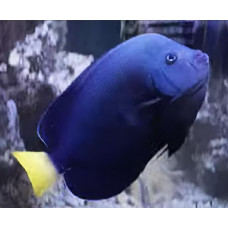Latin name
Chaetodontoplus caeruleopunctatus
Other names
Chaetodontoplus caeruleopunctatus
Identification
The biggest differences between males and females are in their pelvic fins and body shape. Males have an almost round body, split pelvic fins, and a pointed, thin breeding tube. Females are more angular in the ventral and dorsal parts of the body and have a smoother and more rounded head than males.
Features of fish fins
The dorsal fin contains 13 spines and 17 soft rays, while the anal fin has 3 spines and 17 soft rays.
Fish colouring
The head and front of the body are pale orange-brown, while the rest of the body is dark brown to blue-black with dense blue spots. The dorsal and anal fins are dark brown with blue edges, and the caudal fin is bright yellow. Juveniles are dark brown, pearly black with a yellow stripe on the front of the back and another on the head and around the dorsal fin, and the tail is yellow-white.
Distribution
It is endemic to the Philippines, where it is rarely found in the wild.
Habitat
A marine tropical species. They live at depths of 14 to 40 meters (46 to 131 feet). They prefer rocky areas with abundant sponges and algae.
Size
This species reaches a maximum total length of 20 centimeters (7.9 inches).
Behavior
It inhabits reefs and does not migrate.
Food and feeding habits
The diet consists of sponges and shellfish.
Reproduction
Are protogynous hermaphrodites, with all individuals starting out female and the dominant ones developing into males.
Fishing
No commercial value. Of no interest to fishermen.
Relationship with a person
Commonly found in aquariums and bred in captivity.
| Classification | |
| Phylum | Chordata |
| Class | Actinopterygii |
| Squad | Perciformes |
| Family | Pomacanthidae |
| Genus | Chaetodontoplus |
| Species | C. caeruleopunctatus |
| Features | |
| Conservation status | Data Deficient |
| Habitat | Pelagic |
| Life span, years | No information |
| Maximum body weight, kg | No information |
| Maximum length, cm | 20 |
| Sailing speed, m/s | No information |
| Threat to people | Not edible |
| Way of eating | Planktonophage |
Bluespotted angelfish
Tags: bluespotted angelfish


